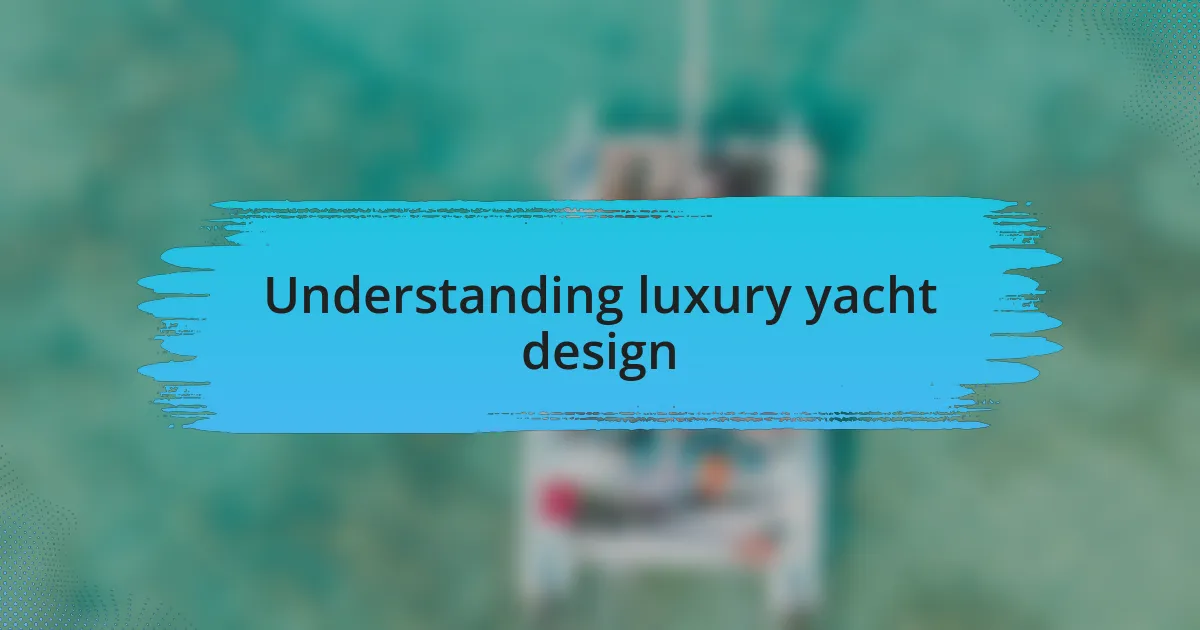Key takeaways:
- Luxury yacht design combines artistry and engineering, emphasizing functionality while creating inviting and comfortable spaces.
- Scaling design is crucial for maximizing space efficiency and enhancing both aesthetic appeal and overall performance of the yacht.
- Key features of luxury yachts include high-quality materials, innovative layouts, and advanced technology that elevate the onboard experience.
- Future trends in yacht design focus on sustainability, modular configurations, and the integration of smart technology to enhance the connection with the environment and maximize versatility.

Understanding luxury yacht design
Luxury yacht design is a fascinating blend of artistry and engineering, where every curve and material choice serves a purpose. I remember walking through a particularly stunning yacht, noticing how the natural light flooded the space, enhancing the luxurious feel. It made me wonder, how do designers balance functionality with such beauty?
The layout is crucial in luxury yacht design, ensuring that every inch is optimized for comfort and style. There was a time I hesitated to step onto a yacht, thinking it might feel cramped. However, I quickly realized that the smartest designs create open, airy spaces, often using innovative storage solutions to keep the interiors uncluttered and inviting. Isn’t it amazing how a well-thought-out space can transform entire experiences out at sea?
Color palettes and material selection also play an essential role in the overall vibe of a yacht. When I first saw a yacht with warm wood finishes contrasted against sleek metal fixtures, I felt immediately drawn to it. It sparked a personal connection, illustrating how design transcends aesthetics, creating environments that resonate emotionally. How do colors and textures on a yacht influence not just the visual impact but also the feelings of those aboard?

Importance of scaling design
Scaling design is vital in luxury yacht construction, as it ensures that each element of the vessel harmonizes seamlessly, regardless of the overall size. I once encountered a beautifully designed yacht that showcased the genius of scaling—the dining area felt expansive despite its compact footprint, creating an inviting space for intimate gatherings. It got me thinking, how does a designer decide what elements to emphasize when space is at a premium?
When considering the layout and flow of a yacht, the importance of scaling becomes even more apparent. I remember stepping onto a yacht with a cleverly designed galley that made me feel as if I had entered a spacious kitchen in a luxury home. The way the cabinetry was scaled down but still felt complete made me realize that thoughtful design can inspire comfort and functionality, even in the tightest quarters. Isn’t it intriguing how clever scaling can redefine our perception of space?
Moreover, scaling affects not just aesthetics but also the boat’s performance. I witnessed this firsthand while sailing on a sleek yacht that was expertly scaled for balance and stability. The difference in handling and comfort was palpable, leading me to appreciate how integral scaling is to the overall experience at sea. How often do we overlook the technical aspects of design that contribute to our adventures on the water?

Key features of luxury yachts
Luxury yachts are distinguished by their unparalleled attention to detail and exceptional craftsmanship. One feature that often stands out is the use of high-quality materials, ranging from rich woods to premium fabrics. I remember being on a yacht where the interior felt like a five-star hotel; the rich textures and elegant finishes created an opulent atmosphere that invited relaxation. How can something as simple as a fabric choice elevate a space to luxurious heights?
Another key feature that captivates me is the innovative layout and spatial efficiency often found in luxury yachts. I was once on a vessel that cleverly integrated multifunctional spaces, transforming a cozy lounge into an inviting dining area with just a few adjustments. It got me thinking about how essential versatility is in the design; thoughtful selections can make even the smallest yacht feel expansive. Have you ever marveled at how a well-planned layout can change the dynamics of a living space?
Additionally, technology plays a pivotal role in defining luxury. I remember being on a yacht equipped with cutting-edge navigation systems and smart home features that made every voyage not just easier but also more enjoyable. That seamless blend of comfort and innovation is what truly sets luxury yachts apart. Just think about it—how different does the experience become when technology enhances our connection with the sea?

Adapting design for tiny living
When adapting design for tiny living, functionality becomes paramount. In my experience, clever storage solutions can transform a cramped space into a sanctuary. I once visited a yacht with hidden compartments cleverly incorporated into the furniture; it was like discovering treasures that maximized every nook, making the living area not only beautiful but highly efficient. Have you ever felt relief stepping into a space where everything has its place?
One design element that resonates with me is the use of light colors and reflective surfaces. They create an illusion of space, making even the smallest areas feel airy and open. I remember the first time I stepped into a compact cabin painted in soft whites and grays; the natural light streaming through the windows, combined with mirrors, created an environment that felt larger than life. Isn’t it fascinating how color and reflection can affect our perception of space?
Additionally, multifunctional furniture is a game-changer in tiny living scenarios. I’ve encountered pieces that seamlessly convert from a sofa to a bed or from an office desk to a dining table. It’s remarkable how these adaptive designs can cater to various needs throughout the day, creating a dynamic living experience. Have you thought about how versatile furniture can influence not just functionality, but also your overall happiness in a smaller space?

Personal experiences with tiny living
Embracing tiny living has taught me the beauty of simplicity. I remember my first experience living in a compact space while traveling; each item I owned felt purposeful and significant. It brought a sense of clarity that I hadn’t realized I was missing when I was surrounded by excess. Have you ever experienced that freeing feeling of letting go?
One of my fondest memories was spending a week on a friend’s small houseboat. Every evening, we would gather on the deck, savoring meals prepared in a tiny kitchen, which surprisingly had everything we needed. It was incredible to witness how a smaller living area fostered deeper connections, as we were always drawn together in a cozy, intimate setting. How often do we find joy in simplicity?
Living in a tiny space has its challenges, but I’ve learned to appreciate the little victories. I recall a time when I transformed a corner of my bedroom into a mini workspace, complete with a foldable desk. Each time I settled in to read or write, I felt a surge of accomplishment, knowing I had created a functional oasis from such limited space. Isn’t it fascinating how small adjustments can lead to significant changes in our daily routines?

Tips for effective yacht scaling
When scaling yacht design, it’s essential to prioritize multifunctional spaces. I recall a time exploring a beautifully designed yacht where the dining area seamlessly transformed into a workspace. It struck me how practicality could override size constraints, creating a lively environment that didn’t sacrifice comfort.
In my experience, integrating smart storage solutions can dramatically enhance the efficiency of small living spaces onboard. I’ve seen stylish under-bed drawers while visiting a friend’s yacht; they were cleverly disguised and kept clutter at bay. Who would have thought that storing items could look so elegant while boosting functionality?
Lastly, I believe that choosing the right materials is crucial for effective yacht scaling. During my visit to a luxury yacht, the use of light, durable materials made the space feel larger and more inviting. When designing such intimate environments, haven’t we all felt how the right textures and colors can define a room’s atmosphere?

Future trends in yacht design
I’m excited to share my thoughts on the future trends in yacht design, particularly as they relate to sustainability. I’ve encountered some innovative designs that feature eco-friendly materials and energy-efficient systems. For example, I recently visited a yacht that utilized solar panels and recycled materials; it was inspiring to see how luxury can harmonize with environmental responsibility. Isn’t it refreshing to think that our rich experiences at sea can also support the planet?
Another trend that I’m noticing is the rise of modular yacht designs, which allow owners to customize their space according to their lifestyle. While touring a contemporary yacht last summer, I marveled at how its modular furniture could be reconfigured for entertaining one day and cozy family gatherings the next. This adaptability isn’t just smart—it’s essential for those of us craving versatility without compromising on elegance.
Lastly, the integration of technology is evolving rapidly in yacht design. I once stepped aboard a yacht equipped with an advanced control system that managed everything from lighting to entertainment with just a tap on a screen. It made me appreciate how intelligent solutions have the power to enhance our onboard experiences. Isn’t it amazing to think about how technology can create a seamless connection between us and the ocean?